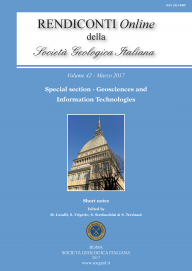
The reconstruction of the Marmousi-2 geological model using the gradient-based time domain acoustic and elastic Full-Waveform Inversion
Daniela Teodor (a)
(a) University of Turin, Earth Sciences Department, Via T. Valperga Caluso, 35, 10125, Turin, Italy. E-mail: d.teodor.univ@gmail.com.
Volume: 42/2017
Pages: 119-122
Abstract
Marmousi-2 is an elastic model defined by the P-wave, the Swave velocities (Vp and Vs respectively) and by the densities of the geological bodies that reproduce a geological profile of North Quenguela
in the Quanza Basin in Angola. This study is focused on the evaluation of the accuracy and quality of the Vp and Vs estimated models and of their Vp to Vs ratio, using the gradient-based acoustic and elastic Full-Waveform Inversion (FWI). Two different initial models have been tested: the first one obtained with Genetic Algorithms (GA) and the second one obtained by applying a smoothing function to the Marmousi-2 true model. These initial models are characterized by variable Vp/Vs ratios, both in depth and in the horizontal direction, which nicely approximate the true geological setting. The analysis of the different tomographic images obtained by the FWI and the model misfit computation proved the good reconstruction of the Vp and Vs model only when the initial model has Vp/Vs ratios that reproduce the depth and the horizontal variations of the true model; this happens because the background trend of Vp/Vs ratio is preserved from the initial to the reconstructed models and is not much modified by FWI.
Furthermore, it was noticed that also the use of an initial model obtained with Genetic Algorithms allows for a good Vp and Vs model reconstruction. However, the final reconstructed model has in this case a lower degree of matching with the true model. Nevertheless, the improvements brought by gradient-based FWI, that is, the decrease of the model misfit between the true model and the reconstructed model, are greater for the GA case compared to the smooth case. Then, starting from a less accurate initial model, the FWI is able to deliver a final model close to the true model.
Keywords
Get Full Text